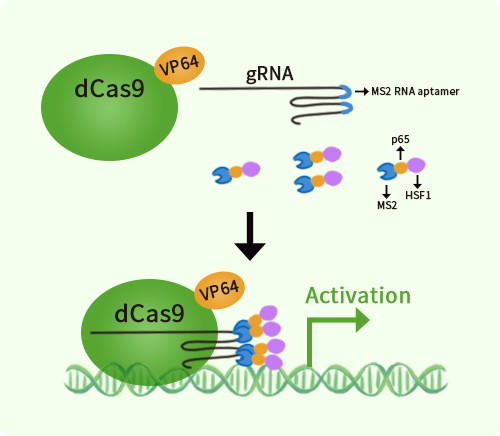Mouse Eed activation kit by CRISPRa
CAT#: GA201184
Eed CRISPRa kit - CRISPR gene activation of mouse embryonic ectoderm development
CNY 12,255.00
Specifications
| Product Data | |
| Format | 3 gRNAs (5ug each), 1 scramble ctrl (10ug) and 1 enhancer vector (10ug) |
| Symbol | Eed |
| Locus ID | 13626 |
| Kit Components | GA201184G1, Eed gRNA vector 1 in pCas-Guide-GFP-CRISPRa GA201184G2, Eed gRNA vector 2 in pCas-Guide-GFP-CRISPRa GA201184G3, Eed gRNA vector 3 in pCas-Guide-GFP-CRISPRa 1 CRISPRa-Enhancer vector, SKU GE100056 1 CRISPRa scramble vector, SKU GE100077 |
| Disclaimer | These products are manufactured and supplied by OriGene under license from ERS. The kit is designed based on the best knowledge of CRISPRa SAM technology. The efficiency of the activation can be affected by many factors, including nucleosome occupancy status, chromatin structure and the gene expression level of the target, etc. |
| Reference Data | |
| RefSeq | NM_021876 |
| Synonyms | ENSMUSG00000039373; l(7)5Rn; l7Rn5; lusk |
| Summary | Polycomb group (PcG) protein. Component of the PRC2/EED-EZH2 complex, which methylates 'Lys-9' and 'Lys-27' of histone H3, leading to transcriptional repression of the affected target gene. Also recognizes 'Lys-26' trimethylated histone H1 with the effect of inhibiting PRC2 complex methyltransferase activity on nucleosomal histone H3 'Lys-27', whereas H3 'Lys-27' recognition has the opposite effect, enabling the propagation of this repressive mark (By similarity). The PRC2/EED-EZH2 complex may also serve as a recruiting platform for DNA methyltransferases, thereby linking two epigenetic repression systems (By similarity). Genes repressed by the PRC2/EED-EZH2 complex include HOXA7, HOXB6 and HOXC8. Plays a role in X chromosome inactivation (XCI), in which one of the two X chromosomes in female mammals is transcriptionally silenced to equalize X-linked gene dosage with XY males. Required for stable maintenance of XCI in both embryonic and extraembryonic tissues. May prevent transcriptional activation of facultative heterochromatin during differentiation. Required for development of secondary trophoblast giant cells during placental development. May regulate hippocampal synaptic plasticity in the developing brain.[UniProtKB/Swiss-Prot Function] |
Documents
Resources
| 基因表达相关资源 |
Other Versions
| SKU | Description | Size | Price |
|---|---|---|---|
| KN505009 | Eed - KN2.0, Mouse gene knockout kit via CRISPR, non-homology mediated. |
CNY 8,680.00 |


 United States
United States
 Germany
Germany
 Japan
Japan
 United Kingdom
United Kingdom
 China
China

